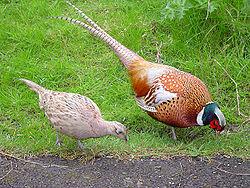Taxonomic classification:
(Regnum): Animals (Animalia)
(Phylum): Vertebrates(Vertebrates)
(Classis): Birds (Phasianidae)
(Ordo): Galliformes (Galiformes)
(Familia): Pheasant
Relatives of the grouse, quail, partridges and chickens. They were mixed with several subspecies during the installation process, butsometimes racial stamps are still obvious.
Occurrence: Original home is from the Caucasus to the Amur River and Burma. It is acclimate to Europe since the Middle Ages (now eight species live here). They like warm and temperate areas.
Habitat: forests, agricultural areas, reeds.
Morphology, Structure:
The physiology of birds: Birds are warm-blooded. The metabolic end-products are eliminated from a single hole, which is also the genital opening, this is called cloaca. Two organs in the digestive system is very typical on the birds, one is the gizzard, which makes small pieces of food, the other is the crop, which works as a chamber store.
The Pheasants are large sized, stocky-bodied, plump, ill-flying land birds. They've got short legs, which are strong and muscular. The three forward-facing toes has thick claws. These morphological features are the results of terrestrial life. Their body length is 53-89 cm, the wingspan is 70−90 cm, the weight is 750 to 1,700 grams.
They wear spurs on their feet. The roosters and hens usually have a very different !!!!, the formers usually have long tails.
The rooster is very colorful: with metallic shiny dark green head, and the nape, which is dark blue. The rooster also has white "collar". The females plumage is light brown with darker spots on her back so they can hide from predators.
Diet: Vegetable diet (seeds), young birds feeding on insects supplement. They eat food collected from the ground.
Habits: bird, avoiding the water. Predators prefer them. They do not really like flying. If you discover them, they suddenly stirr up from the vegetation with great wings, and then they quickly subside. They love spending nights − especially in snowy winters − on trees because they feel safe there.
Reproduction: A fancy feathered cock tries to conquer many hens. The hens choose their couple according to the length of their spurs. Females build a nest lined with grass and leaves on the ground. The female brood on the chicks, she also breeds them. Hens brood on 12-18 eggs, from 22 to 28 days. About half of the hatched animals die before the age of nine weeks, and only about the 30% of the pheasants reach the adulthood. Only 5% of them reach the age of 3, the total stock exchange occurs in every five years.
Role in the ecosystem: the unmade or turf table borders are excellent opportunity for wildlife (feeding, nesting and hiding places). They also offer protection against pests and weeds, because the useful animals hiding in the table borders, such as the pheasant, destroy the pest insects in the board's internal parts as well. Furthermore, they eat the weed seeds, thus inhibiting their reproduction.
The role on the soil: They mix the soil while looking for nutrition with their powerful beak .
Vulnerability: The chicks leave the nest very early, and they follow their mother everywhere. When mowing their nest can be destroyed. They reproduce well in captivity, hence they are not on the edge of extinction.
Expediency for humans: They are frequent in Hungary, they are breed as well. They are popular birds of hunters. The main motivation is for sport hunting, and not for food, but they are delicious.
Simon Tiller: Az állatvilág enciklopédiája A-tól Z-ig, Új Esély Kiadó Kft. Budapest, 1994
Dönsz Judit: Európa vadvilága, Graph-Art Stúdió Kft. Debrecen, 2000
Az állatvilág kalendáriuma -The Wildlife Year, London, 1991,
www.facanok.hu
